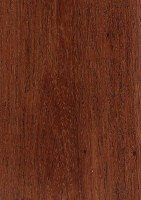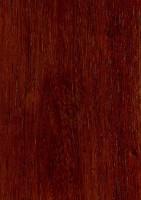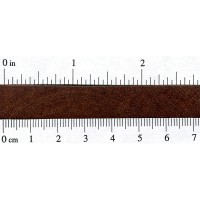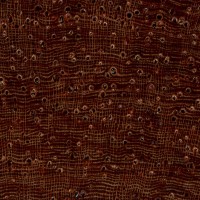 |
Common Name(s): Burmese Rosewood Scientific Name: Dalbergia oliveri Distribution: Primarily Myanmar (formerly Burma), and other southeast Asian nations Tree Size: 50-100 ft (15-30 m) tall, 1-3 ft (.3-1 m) trunk diameter Average Dried Weight: 59 lbs/ft3 (940 kg/m3) Specific Gravity (Basic, 12% MC): .78, .94 Janka Hardness: 2,710 lbf (12,060 N) Modulus of Rupture: No data available Elastic Modulus: No data available Crushing Strength: No data available Shrinkage: Radial: ~2%, Tangential: ~5%, Volumetric: ~7% |
Color/Appearance: Heartwood color ranges from an medium orange to a darker reddish brown; sometimes with darker black streaks. Yellow sapwood is clearly demarcated from heartwood. Color tends to darken with age, though it tends to maintain its color better than other colorful exotic woods.
Grain/Texture: Grain is usually straight or slightly interlocked. Medium-fine texture and a good natural luster.
Endgrain: Diffuse-porous; very large pores in no specific arrangement, very few to few; solitary and radial multiples of 2-3; heartwood deposits (red and dark brown) common; narrow rays not visible without lens, spacing fairly close; parenchyma vasicentric, winged, and reticulate.
Rot Resistance: Rated as very durable regarding decay resistance, with mixed resistance to insect attacks.
Workability: Generally easy to work with both hand and machine tools, though it can blunt cutting edges rapidly. Care should be taken in gluing and finishing, due to natural oils in the wood that can disrupt the drying process. Turns and polishes well.
Odor: Burmese Rosewood has a distinct, rosewood-like scent while being worked.
Allergies/Toxicity: Although severe reactions are quite uncommon, rosewood in the Dalbergia genus, (such as Burmese Rosewood), has been reported as a sensitizer. Usually most common reactions simply include eye, skin, and respiratory irritation. See the articles Wood Allergies and Toxicity and Wood Dust Safety for more information.
Pricing/Availability: Availability is somewhat limited, but Burmese Rosewood isn’t as scarce as some of the other more endangered rosewoods. Expect prices to be in the mid to upper range for an imported tropical species.
Sustainability: Burmese Rosewood is listed on CITES appendix II under the genus-wide restriction on all Dalbergia species—which also includes finished products made of the wood. It is also listed on the IUCN Red List as endangered due to a population reduction of over 50% in the past three generations, caused by a decline in their natural range, and exploitation.
Common Uses: Furniture, flooring, musical instruments (percussion), turned objects, and other small specialty wood items.
Comments: Burmese Rosewood is one of the lesser-known rosewoods, though it’s a well-known tonewood within its natural range. The wood is used for the bars of the ranad ek, a traditional Thai xylophone.
- African Blackwood (Dalbergia melanoxylon)
- Amazon Rosewood (Dalbergia spruceana)
- Bois de Rose (Dalbergia maritima)
- Brazilian Rosewood (Dalbergia nigra)
- Burmese Blackwood (Dalbergia cultrata)
- Cocobolo (Dalbergia retusa)
- East Indian Rosewood (Dalbergia latifolia)
- Honduran Rosewood (Dalbergia stevensonii)
- Kingwood (Dalbergia cearensis)
- Madagascar Rosewood (Dalbergia baronii)
- Siamese Rosewood (Dalbergia cochinchinensis)
- Sissoo (Dalbergia sissoo)
- Tulipwood (Dalbergia decipularis)
- Yucatan Rosewood (Dalbergia tucurensis)








I pulled this out of a table manufactured in Vietnam. My wood identification group spent a few hours debating what it could be, but we could not come to a consensus, so I’m hoping the expert can help us out here. The group was leaning towards something Dalbergia, or possibly Pterocarpus or Narra. I had considered Koompassia, but I’d love to get your feedback whenever you get the chance! Apologies for the sorry state of the face grain, this stuff seemed particularly hostile to my hand plane
What does it smell like?
No odor that I could detect, not even while cutting or sanding
it is not the wood you want,burmese rose always with a strong order similar appleViniger while standing or saving.
Burmese Rosewood in thailand (we call Ching chan wood) average strength data is
Janka Hardness 12,317 N
Modulus of Rupture 174 MPa
Crushing Strength 126 MPa
May will help for everyone
Thanks for that data. Would you mind sharing where you got that information from? I like to have a source for all the data that I put online.
Data from Department of Forestry in thailand since 2005 ago
https://forprod.forest.go.th/forprod/techtransfer/document/%E0%B8%84%E0%B8%A5%E0%B8%B1%E0%B8%87%E0%B8%84%E0%B8%A7%E0%B8%B2%E0%B8%A1%E0%B8%A3%E0%B8%B9%E0%B9%89/4.%20%E0%B8%81%E0%B8%B2%E0%B8%A3%E0%B9%83%E0%B8%8A%E0%B9%89%E0%B8%9B%E0%B8%A3%E0%B8%B0%E0%B9%82%E0%B8%A2%E0%B8%8A%E0%B8%99%E0%B9%8C%E0%B9%84%E0%B8%A1%E0%B9%89%E0%B9%81%E0%B8%A5%E0%B8%B0%E0%B8%9C%E0%B8%A5%E0%B8%B4%E0%B8%95%E0%B8%9C%E0%B8%A5%E0%B8%88%E0%B8%B2%E0%B8%81%E0%B8%9B%E0%B9%88%E0%B8%B2/%E0%B8%AD%E0%B8%B8%E0%B8%95%E0%B8%AA%E0%B8%B2%E0%B8%AB%E0%B8%81%E0%B8%A3%E0%B8%A3%E0%B8%A1%E0%B9%84%E0%B8%A1%E0%B9%89/3.%E0%B8%81%E0%B8%B2%E0%B8%A3%E0%B8%95%E0%B8%A3%E0%B8%A7%E0%B8%88%E0%B8%9E%E0%B8%B4%E0%B8%AA%E0%B8%B9%E0%B8%88%E0%B8%99%E0%B9%8C/1.%E0%B9%84%E0%B8%A1%E0%B9%89%E0%B9%80%E0%B8%99%E0%B8%B7%E0%B9%89%E0%B8%AD%E0%B9%81%E0%B8%82%E0%B9%87%E0%B8%87%E0%B8%82%E0%B8%AD%E0%B8%87%E0%B8%9B%E0%B8%A3%E0%B8%B0%E0%B9%80%E0%B8%97%E0%B8%A8%E0%B9%84%E0%B8%97%E0%B8%A2.pdf
When I click on the link, it says error 521 web server is down. Any chance you can copy and paste more info, or post the name of the link so we can google it? I’m always looking for more information on wood species, so I’d be interested to read if there’s been studies done on this wood.
I upload file in google drive
Burmese Rosewood (??????) list at No.17
https://drive.google.com/file/d/1rYGcx0NLk9F3OoO9xS31gAJ1aGu-q3bE/view?usp=sharing
Can burmese rosewood have the same color variations as cocobolo, is burmese rosewood’s sapwood dark colored, I bought a blank that I think might be burmese rosewood. I think the blank could be burmese rosewood because the wood has hints of magenta and dark cranberry-red with black and brown stripes, however the wood has a scent reminiscent to cocobolo.